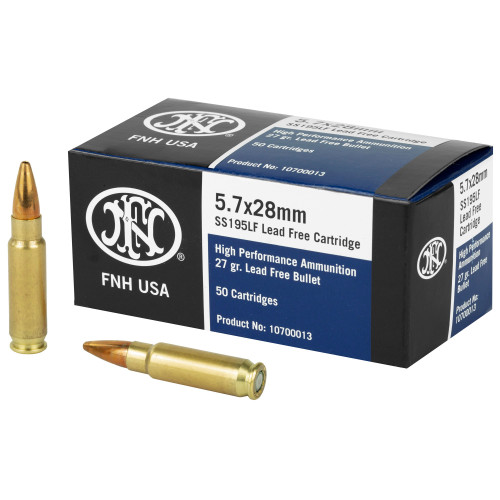5.7x28mm Ammo

5.7x28mm: In Depth
When NATO called on arms manufacturers to design a replacement for 9mm Parabellum back in the late 80s, FN (Fabrique Nationale, out of Belgium) was focused on moving the caliber discussion to a much smaller round. This was around the same time that 10mm, .40 S&W, and other calibers larger than 9mm Luger were seeing adoption across the ranks of America’s law enforcement. A key consideration for whatever cartridge replaced (or supplemented) 9mm was the ability to penetrate body armor, so it had to be fast. It also needed to be accurate, have a longer range than 9mm, and have a greater effect on targets downrange.
The results of FN’s development efforts were the 5.7x28mm cartridge, followed shortly by the P90 personal defense weapon (PDW) and Five-seven pistol a few years after that. The first 23-gr. loads rocketed out of the compact P90 at 2,800/fps. Later loadings changed to a heavier 31-gr. bullet at more than 2,350/fps in order to function more effectively out of the Five-seven pistol. Regardless of which load you pick between those two, this is ridiculous velocity for a cartridge designed to shoot from a pistol.
However, 5.7x28mm isn’t a normal pistol cartridge. In fact, depending on who you ask, this actually isn’t a pistol cartridge. This round plays by different rules in a league all its own. For starters, it has no parent case, so no easy comparisons to make there. The projectiles are also a mere .220 caliber in, which is smaller in diameter than .22LR’s projectiles! And, to top it all off, 5.7x28mm bests the velocities found in most pistol rounds by more than 200%, and many magnums by several hundred fps, when fired through a weapon like the P90.
In the later 90s and beyond, specialized military and law enforcement units around the world adopted the P90 PDW, and to a lesser extent, the Five-seven pistol. In the last decade, a flurry of new pistols chambered in 5.7x28mm entered the market, which has swelled the ranks of its devotees. NATO did eventually elevate 5.7x28mm to its short list of preferred calibers, but this didn’t happen until the cartridge was over thirty years old, with the announcement finally made around March of 2021.
5.7x28mm: Guns
Not only did FN oversee the development of this 5.7x28mm, they also manufactured the only firearms that shot it for much of its history. However, nearly thirty years after it was released to the world, 5.7x28mm shooters rejoiced when Ruger released a polymer pistol to compete with FN’s famous Five-seven. Before long, Smith and Wesson, Palmetto State Armory, and Kel-Tec would all join the 5.7 party with pistols of their own. Most of these, with the exception of the Kel-Tec, are said to be quality, reliable pistols. While it’s unlikely that you’ll ever get your hands on an actual P90 (it’s a post-86 machine gun), the semi-auto, long-barreled version known as the PS90 is available all over the place, and Ruger’s LC Carbine is also chambered in 5.7x28mm, as is Kel-Tec’s R50. So, if you’d like to see this cartridge stretch its legs, you’ll definitely get more velocity from 5.7x28mm with one of these carbine, PDW, or rifle options.
Semi-Auto Pistols
- FN Five-Seven
- Ruger 57
- S&W M&P 5.7
- Kel-Tec P50
- PSA 5.7 Rock
Semi-Auto PDWs / Carbines / Rifles
- FN PS90
- Ruger LC Carbine
- Kel-Tec R50
Why Choose 5.7x28mm?
Originally designed for short-barreled weapons like the P90, this round was also an attempt to replace 9mm Luger outright by shooting flatter, more accurately, and ideally, right through body armor. Up until a few years ago, 5.7x28mm was a bit of a novelty for civilian shooters in the US, but that’s changing with the flood of new pistols, PDWs, and carbines that have come out just recently. While you’ll need the correct combination of barrel length and ammunition to defeat body armor – ammunition that can be expensive and difficult to locate – this is still a great cartridge choice for a full sized self defense pistol or home defense carbine using commonly available ammunition. For target shooters, this is an inherently accurate and flat-shooting round, and it may drop in price now that so many gun manufacturers have jumped into the game in recent years.
Self Defense
- Full sized pistols are available now from Ruger, S&W, and PSA that are far cheaper than the OG Five-seven from FN.
- Little to no recoil.
- Twenty+ round capacity with standard mags in newer pistols.
Target
- Flat shooting and accurate round.
- Prices on ammunition may come down as more people purchase 5.7x28mm firearms and ammo supply increases to meet demand.
5.7x28mm: Ammo Brands and Loadings
There are fewer manufacturers of 5.7x28mm ammo compared to most other pistol rounds. This may change with time, considering that the round is a) now a standard “NATO caliber”, and b) becoming more popular with American shooters, due to more pistols being released every year in the chambering. Note: the military load developed by FN to penetrate soft body armor, known as SS190, is not readily available to civilians. The “sporting” loads for sale in the US by the major manufacturers will not penetrate most IIIA armor, especially out of a handgun. With any luck, manufacturers will step in with more FMJ offerings for range practice at a reasonable cost, but for now, boxes of 5.7x28mm command a premium price, regardless of the loading.
Brands
Standard Loading
- 40-gr. Polymer-Tip, FMJ, or HP@ 1,800/fps
Bullet Types
- Polymer-Tip - Self Defense, Target
- FMJ (Full Metal Jacket) - Target
- HP (Hollow Point) - Self Defense, Target
Bullet Weights
- 27-gr. to 40-gr. - Self Defense, Target
- 62-gr. - Subsonic target ammo
Velocities
- 27-gr. to 40-gr. - 1,600/fps to 2,200/fps based on barrel length
- 62-gr. - 1,050/fps pistol (Some reports of supersonic velocities in PS90 carbines)
Subsonic Ammo
- Fiocchi makes a 62-gr. subsonic load designed for suppressed shooting. Note: this ammo may not be subsonic when fired through a carbine-length barrel.
5.7x28mm: Frequently Asked Questions
This depends on the rating of the armor, as well as the load and gun used.Generally, factory loaded 5.7x28mm ammo available to civilians is not armor piercing.
Suffice to say that the military SS190 load will penetrate IIIA soft body armor when fired out of a 10”-barreled P90.
Neither cartridge has a distinct advantage over the other at self-defense ranges.
The ammo and firearm choices for 9mm Luger, including concealed carry guns, make 9mm the far better choice for most people
Low recoil and very high capacity magazines both make this an appealing choice for a home defense pistol.
Also could be a good choice for HD in a compact carbine or PDW-style gun.
The extra velocity you gain with longer barrels would mean more devastating results to targets.









